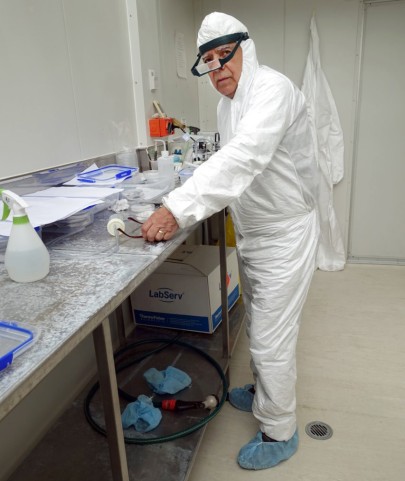Chilean Flame Creeper Beetle Living up to its Promise

Dr Hernan Norambuena in the containment facility
The first batch of plants on the test list are the species most closely related to Chilean flame creeper: species in the genus Tropaeolum. They comprise five climbing Tropaeolum species, which are grown as ornamentals (one of which has edible tubers), and two species of nasturtium. Not surprisingly, all of the Tropaeolum species are acceptable hosts to the beetle. Interestingly, the climbing Tropaeolum species all produce their foliage in winter, when both Chilean flame creeper and the beetle are dormant. It is likely that this seasonal offset will preclude any non-target attack. Also, Hernan could not find the beetle on these potential host plants in the wild in Chile in his late winter/early spring surveys the previous year. In fact we had to grow these hosts in a controlled environment mimicking winter to ensure we had foliage for testing when the beetles are naturally active.
Next, we tested a group of species and genera more phylogenetically distant from the genus Tropaeolum. The closest relatives in this group are two tropical species, papaya and moringa, two unlikely candidates to ever be in proximity of Chilean flame creeper, which is a serious weed in climatically cool regions of the South Island. These test plants also had to be maintained in a controlled environment to encourage growth, except in this case it was a perpetual summer environment that had to be mimicked.
The largest group of species we tested are in the family Brassicaceae, the cabbage family, which is in the plant order Brassicales along with the genus Tropaeolum. The Brassicaceae was a crucial family to test, with numerous native and economically important species and varieties. “We needed to think hard about which species and varieties will be sufficiently representative of the family,” explained Ronny Groenteman, who is leading the project. “After much deliberation, we landed on five indigenous species and five commercially grown species, two of them represented by three varieties each,” she added.
All of the tests Ronny and team conducted were ‘no-choice’, meaning that the beetle larvae were presented with the test species alone in Petri dishes. Under such conditions we do expect larvae that must eat or die to nibble on some test plants that are closely related to the target weed. Indeed, some larvae did nibble on some hosts, and a few even managed to develop through a few larval stages. One individual each managed to develop to the adult stage on moringa, Chinese cabbage, and pak choi.
A preliminary data analysis calculated a risk score for moringa and Chinese cabbage becoming field hosts at less than 5%. This is before taking into account the low likelihood of these potential host plants growing in the vicinity of Chilean flame creeper. The risk score for pak choi was higher at around 24%, which is slightly more concerning, warranting further investigation into this species next spring to adequately assess the potential risk.
During testing we learnt a lot more about the biology of the beetle. Under stable conditions in the containment room the new generation adults started ovipositing fertile eggs without going through a dormant period. This may suggest that a winter diapause for egg production is not obligatory, or perhaps that the beetle has multiple generations per year.
There is still a lot to learn about this beetle, but suffice to say it is looking sufficiently host specific for release in New Zealand. We will soon start pre-application consultation for an EPA release application for the Chilean flame creeper leaf beetle.
Funding
This project is funded by the Ministry for Primary Industries’ Sustainable Food, Fibre and Futures Fund (Grant #20095) and the National Biocontrol Collective.

